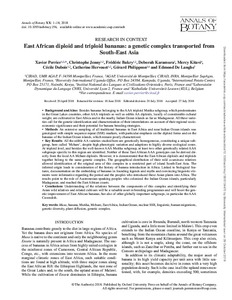All the edible AA varieties studied here are genetically homogeneous, constituting a unique subgroup,
here called ‘Mchare’, despite high phenotypic variation and adaptions to highly diverse ecological zones.
At triploid level, and besides the well-known AAA Mutika subgroup, at least two other genetically related AAA
subgroups specific to this region are identified. Neither of these East African AAA genotypes can be derived directly
from the local AA Mchare diploids. However, it is demonstrated that the East African diploids and triploids
together belong to the same genetic complex. The geographical distribution of their wild acuminata relatives allowed identification of the original area of this complex in a restricted part of island South-East Asia. The inferred origin leads to consideration of the history of banana introduction in Africa. Linked to biological features, documentation on the embedding of bananas in founding legends and myths and convincing linguistic elements were informative regarding the period and the peoples who introduced these Asian plants into Africa. The results point to the role of Austronesian-speaking peoples who colonized the Indian Ocean islands, particularly Madagascar, and reached the East African coasts.
East African diploid and triploid bananas: a genetic complex transported from South-East Asia
Citation: Perrier, X.; Jenny, C.; Bakry, F.; Karamura, D.; Kitavi, M.; Dubois, C.; Hervouet, C.; Philippson, G.; De Langhe, E. (2018). East African diploid and triploid bananas: a genetic complex transported from South-East Asia. Annals of Botany Vol. XX, p. 1–18 ISSN: 0305-7364
2018-10-09
Africa
journal_article

